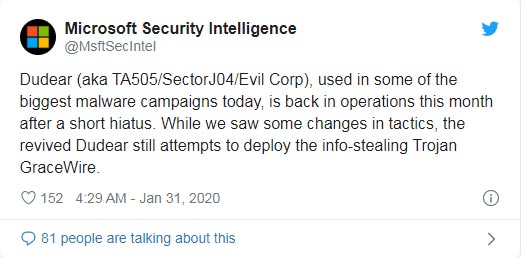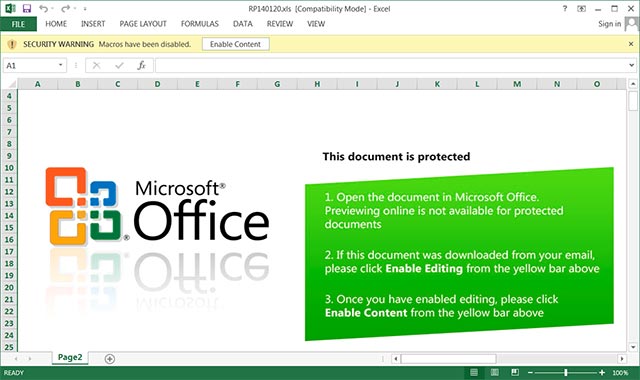Excel continues to be used as a lure for online fraud with complex mechanisms
This attack was developed by the TA505 hacker group (also known as Evil Corp or SectorJo4) specializing in malicious financial campaigns. This group of hackers is no stranger to global cybersecurity organizations after successful campaigns targeting large retail and financial institutions, using the Necurs botnet, causing millions of dollars in damage. . The group is currently working on another campaign using the Excel tool to lure 'gullible' people.

According to findings from Microsoft Security Intelligence, TA505's new offensive campaign will send victims attachments with HTML redirection using malicious Excel documents. Through these malicious documents, the hacker attached a remote access trojan (RAT), as well as a malware downloader that distributes Dridex and Trick malware to the victim's system, targeting the data. Data, financial accounts on the system.
More dangerous, malicious Excel documents distributed by TA505 not only contain Trojans, but also attach malicious ransomware such as Locky, BitPaymer, Philadelphia, GlobeImposter, Jaff.
'TA505's new offensive campaign uses HTML redirects attached to emails. When opened, HTML led to download Dudear, an Excel file containing malicious macros into the victim's system '.
So when opening an HTML attachment, the victim will automatically download the malicious Excel file, and this is what they encountered:

After the victim clicked on Enable Editing and Enable Content as instructed in the document, they accidentally released the malware onto their system.
This malware includes GraceWire - a Trojan designed to steal information, collect sensitive information and forward data obtained via a command and control server (C2 Server).
Until this malicious campaign is stopped, the most effective preventive measure will still be refusing to open strange emails, downloading attachments as well as accessing unauthenticated links.
You should read it
- Microsoft urgently warns about a phishing campaign that uses malicious Excel macros to hack PCs
- [Infographic] 4 types of Phishing are easy to trap users
- 25% of 'over-the-counter' phishing emails are the default security of Office 365
- [Infographic] How to recognize and prevent Phishing attacks
- The 4 most popular network attacks towards older people in 2018
- Hacker purged two-factor security just by automated phishing attacks
- GitHub is under strong phishing attack, users pay attention to account security
- Simple way to convert Excel files to PDF
- New phishing attacks appear to use Google Translate as a disguise
- Hackers found a way to bypass Microsoft Office 365 Safe Links
- Attack analysis uses Excel 4.0 macros to disguise
- Guidance on how to align Excel correctly
May be interested

Why must India implement security systems for the power sector?

Microsoft accidentally exposed 250 million online customer service records

Ako ransomware is raging all over the world, what do you know about this ransomware?

Even mobile sensors can become phishing attacks

Israel launches the world's first cybersecurity network

70,000 Tinder users are circulating on a hacker forum, all of them female






 A complete guide to Excel 2016 (Part 14): Create complex formulas
A complete guide to Excel 2016 (Part 14): Create complex formulas 7 forms of fraud, popular online fraud
7 forms of fraud, popular online fraud Phishing tricks are becoming more and more cunning
Phishing tricks are becoming more and more cunning How to use Excel Online online for free
How to use Excel Online online for free These heartless scams take advantage of Covid-19 in China
These heartless scams take advantage of Covid-19 in China The Zeus Trojan continues to plague the United States
The Zeus Trojan continues to plague the United States